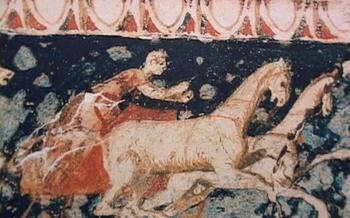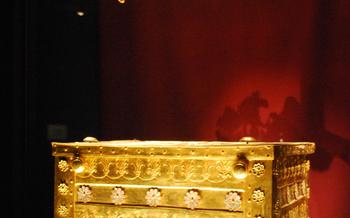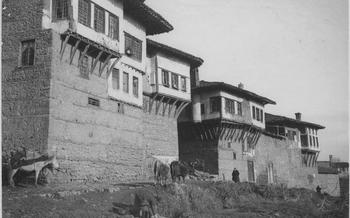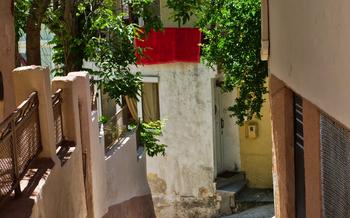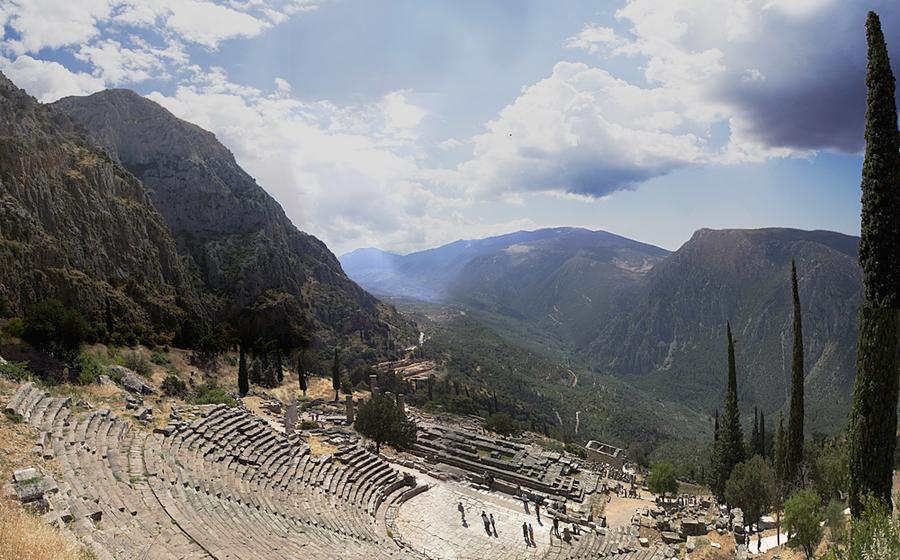
The Museum of the Royal Tombs at Aigai
- A Journey Through Time: Exploring the Ancient City of Aigai
- The Royal Tombs: Unlocking the Secrets of Ancient Macedonian Rulers
- The Gold of Macedonia: Treasures from the Royal Tombs
- The Tomb of Philip II: A Majestic Masterpiece of Ancient Architecture
- The Tomb of Alexander IV: A Touching Tribute to a Young King
- The Ancient Macedonian Burial Rituals and Customs
- Educational Programs and Workshops at the Museum
- The Museum's Contribution to Archaeological Research
- Photography and Videography Guidelines
- Accessibility and Facilities at the Museum
- Insider Tip: Unveiling the Hidden Gem of the Museum
A Journey Through Time: Exploring the Ancient City of Aigai
As you step into the ancient city of Aigai, prepare to embark on a journey through time, where the echoes of history linger in every stone and ruin. Aigai, the first capital of the mighty kingdom of Macedon, holds within its boundaries the secrets of a civilization that shaped the course of ancient history.
Explore the foundations of the Macedonian empire, where the footsteps of Alexander the Great's ancestors once tread. Unravel the origins and development of a culture that rose from humble beginnings to become a dominant force in the ancient world. Discover the secrets of the ancient Macedonian palaces and temples, where power and intrigue played out against a backdrop of splendor and grandeur.
Immerse yourself in the daily life and culture of the ancient Macedonians. Imagine the bustling marketplaces, the vibrant festivals, and the intellectual pursuits that defined their society. Aigai offers a glimpse into a world where warriors and philosophers, artisans and statesmen, intertwined their destinies to create a legacy that would forever shape the course of history.
The Royal Tombs: Unlocking the Secrets of Ancient Macedonian Rulers
The Museum of the Royal Tombs at Aigai boasts an extraordinary collection of royal tombs, each offering a glimpse into the lives and legacies of ancient Macedonian rulers. These tombs have captivated the imagination of archaeologists and history enthusiasts alike, revealing fascinating insights into the grandeur, artistry, and symbolism of the ancient Macedonian kingdom.
As you explore the museum, you'll encounter the final resting places of some of Macedonia's most prominent rulers, including Philip II and Alexander IV. These tombs are not merely architectural marvels but also treasure troves of priceless artifacts that shed light on the opulence and craftsmanship of the ancient Macedonians.
The intricate symbolism and iconography depicted within the tombs provide valuable clues about the beliefs, values, and aspirations of the Macedonian royalty. From elaborate wall paintings to finely crafted sculptures, every detail holds significance, offering glimpses into the rich cultural and religious traditions of ancient Macedonia.
Discover the captivating stories of the Macedonian kings and queens buried within these tombs. Learn about their triumphs and tragedies, their ambitions and legacies. Each tomb tells a unique tale, adding to the rich tapestry of ancient Macedonian history.
These royal tombs are not just historical relics; they are portals into a bygone era, allowing us to connect with the lives and achievements of ancient Macedonian rulers. As you explore the Museum of the Royal Tombs at Aigai, you'll gain a deeper understanding of the grandeur and complexity of this ancient civilization.
The Gold of Macedonia: Treasures from the Royal Tombs
The Museum of the Royal Tombs at Aigai is a treasure trove of exquisite gold artifacts that offer a glimpse into the wealth and artistry of the ancient Macedonians. These precious objects, discovered in the royal tombs, showcase the exceptional craftsmanship and technical skills of the ancient goldsmiths.
Among the most impressive gold artifacts are the intricate jewelry pieces, such as necklaces, earrings, bracelets, and rings. These adornments feature delicate filigree work, intricate granulation, and vibrant gemstones. The goldsmiths demonstrated their mastery in creating realistic depictions of animals, flowers, and mythical creatures, which adorn these exquisite pieces.
Of particular note is the gold wreath found in the tomb of Philip II. This stunning headdress, made of interwoven gold leaves and flowers, is a testament to the skill and artistry of the ancient Macedonian goldsmiths. The wreath is adorned with intricate details, including lifelike depictions of acorns and oak leaves, symbolizing strength and vitality.
The gold artifacts from the royal tombs also include crowns, diadems, and other royal insignia. These pieces, often adorned with precious gems and intricate engravings, served as symbols of power and authority. The goldsmiths employed various techniques, such as repoussé and chasing, to create these magnificent pieces, showcasing the high level of craftsmanship and artistry that characterized ancient Macedonian goldsmithing.
The discovery of these gold artifacts has shed light on the cultural and historical significance of gold in ancient Macedonia. Gold was not merely a symbol of wealth and power but also held religious and symbolic importance. The ancient Macedonians believed that gold possessed divine qualities and associated it with the gods and goddesses of their pantheon.
Unveiling the secrets behind the goldsmithing techniques used by the ancient Macedonians is a fascinating aspect of exploring the Museum of the Royal Tombs at Aigai. The museum provides insights into the tools, materials, and processes employed by these skilled artisans. Visitors can marvel at the intricate designs and exceptional craftsmanship that have stood the test of time, offering a tangible connection to the artistry and creativity of the ancient Macedonian civilization.
The Tomb of Philip II: A Majestic Masterpiece of Ancient Architecture
The Tomb of Philip II, the father of Alexander the Great, stands as a testament to the grandeur and artistry of ancient Macedonian architecture. Discovered in 1977 by Greek archaeologist Manolis Andronikos, this awe-inspiring tomb is a masterpiece of design and construction.
Intricate wall paintings adorn the tomb's interior, depicting scenes from Greek mythology and Macedonian history. These vibrant frescoes offer a glimpse into the beliefs and values of the ancient Macedonians, showcasing their admiration for bravery, honor, and the divine.
The tomb's most striking feature is its elaborate mosaic floor, depicting a chariot race with intricate details and lifelike figures. This stunning mosaic, considered one of the finest examples of ancient Greek art, showcases the exceptional craftsmanship and artistic skill of the Macedonian artisans.
The discovery of Philip II's tomb was a groundbreaking moment in archaeological history, shedding new light on the life and achievements of Alexander the Great's father. The tomb's rich contents, including gold jewelry, weapons, and armor, provided valuable insights into the opulence and power of the Macedonian monarchy.
This remarkable tomb is a must-see attraction for anyone interested in ancient history, archaeology, or art. It offers a unique opportunity to step back in time and experience the grandeur of the ancient Macedonian kingdom.
The Tomb of Alexander IV: A Touching Tribute to a Young King
Amidst the grandeur of the royal tombs at Aigai, one stands out with a poignant story—the tomb of Alexander IV, the son of Alexander the Great. Unlike his father's majestic resting place, Alexander IV's tomb exudes a sense of melancholy, reflecting the tragic fate that befell this young king.
Discovered in 1977, the tomb's unique features and symbolism offer a glimpse into the life and untimely demise of Alexander IV. The tomb's relatively modest size and lack of lavish decoration hint at the circumstances surrounding his death. As the son of Alexander the Great and Roxana, Alexander IV was caught in the power struggles that ensued after his father's death.
The tomb's design and iconography provide clues to the complex emotions surrounding Alexander IV's passing. The intricate wall paintings depict scenes of hunting and battle, symbolizing his royal lineage and aspirations. Yet, the overall somber tone of the tomb suggests a sense of loss and mourning.
The discovery of Alexander IV's remains, along with those of his mother Roxana, adds to the poignancy of his story. The fact that they were buried together suggests a desire to reunite them in death, perhaps providing solace to those who mourned their tragic end.
The tomb of Alexander IV stands as a testament to the fragility of power and the fleeting nature of life. It invites visitors to reflect on the complexities of ancient Macedonian history and the human stories behind the grand monuments of Aigai.
The Ancient Macedonian Burial Rituals and Customs
The ancient Macedonians held elaborate burial rituals and customs that reflected their beliefs about death and the afterlife. These rituals were designed to honor the deceased and ensure their safe passage to the next world.
Elaborate Tomb Offerings and Grave Goods: The Macedonians believed that the deceased would need certain items in the afterlife, so they buried their dead with a variety of grave goods. These offerings included jewelry, clothing, weapons, tools, and even food and drink. The quality and quantity of the grave goods depended on the status and wealth of the deceased.
Significance of the Tomb Offerings: The offerings placed in the tombs were not merely symbolic; they were believed to have practical significance. The Macedonians believed that the deceased would use these items in the afterlife, so they took great care in selecting and preparing them.
Beliefs about Death and the Afterlife: The Macedonians believed that death was a natural part of life and that the afterlife was a continuation of existence in a different realm. They believed that the soul would journey to the underworld, where it would be judged by the gods and assigned to a place of reward or punishment.
Cultural Identity of the Ancient Macedonians: The burial rituals and customs of the ancient Macedonians were an important part of their cultural identity. These rituals helped to define their beliefs about death and the afterlife and to shape their society's values and practices.
Educational Programs and Workshops at the Museum
The Museum of the Royal Tombs at Aigai is committed to promoting knowledge and understanding of ancient Macedonian history and culture, and it offers a range of educational programs and workshops to facilitate this. These programs are designed for visitors of all ages and interests, providing hands-on activities, interactive exhibits, and opportunities for learning and engagement.
For children, the museum offers educational programs that bring ancient Macedonian history to life through storytelling, games, and hands-on activities. These programs allow children to explore the museum's exhibits in a fun and engaging way, fostering their curiosity and interest in archaeology and history.
Adults can participate in workshops and lectures that delve deeper into specific aspects of ancient Macedonian culture and history. These programs are led by experts in the field and provide a unique opportunity to learn from leading scholars and researchers.
The museum also offers educational programs for schools and groups, providing tailored experiences that meet the specific needs and interests of each group. These programs can include guided tours, interactive workshops, and hands-on activities, ensuring that students have a memorable and educational experience.
Through its educational programs and workshops, the Museum of the Royal Tombs at Aigai plays a vital role in promoting knowledge and understanding of ancient Macedonian history and culture, inspiring a new generation of scholars and enthusiasts to continue exploring this fascinating period of history.
The Museum's Contribution to Archaeological Research
The Museum of the Royal Tombs at Aigai is not just a repository of ancient artifacts; it's also a hub of ongoing archaeological research and excavations. The museum's team of experts is dedicated to unearthing new discoveries and shedding light on the ancient Macedonian civilization.
Through their tireless efforts, the museum has been instrumental in uncovering new royal tombs, uncovering hidden chambers, and revealing previously unknown artifacts. These discoveries have significantly contributed to our understanding of Macedonian history and culture, providing invaluable insights into the lives, customs, and beliefs of this ancient civilization.
The museum's research team is also actively involved in the restoration and preservation of the ancient tombs and artifacts. They employ cutting-edge techniques to conserve and protect these precious relics, ensuring their preservation for future generations.
By supporting archaeological research and excavations, the Museum of the Royal Tombs at Aigai plays a vital role in expanding our knowledge of ancient Macedonia and safeguarding its rich cultural heritage.
Photography and Videography Guidelines
Photography and videography are permitted within the Museum of the Royal Tombs at Aigai, subject to certain guidelines and restrictions. Visitors are allowed to capture still images and videos for personal, non-commercial use. However, the use of tripods, flash photography, and any professional photography or videography equipment is prohibited. This is to ensure the preservation of the artifacts and the overall visitor experience.
The museum's policy aims to strike a balance between allowing visitors to document their experience and protecting the delicate artifacts on display. By adhering to these guidelines, visitors can help preserve the museum's treasures for future generations while still capturing their memories of this remarkable destination.
Accessibility and Facilities at the Museum
The Museum of the Royal Tombs at Aigai is committed to providing an accessible and welcoming environment for all visitors. The museum features wheelchair ramps, elevators, and accessible restrooms to ensure that visitors with disabilities can have a comfortable and enjoyable experience. Visitors who require assistance or have specific accessibility needs are encouraged to contact the museum in advance to make arrangements.
Additionally, the museum offers a variety of resources and services to enhance the experience for all visitors. Guided tours are available in multiple languages and can be tailored to accommodate different interests and abilities. Audio guides and Braille signage are also available to provide additional information and support for visitors with visual impairments. The museum staff is friendly and knowledgeable and is always happy to assist visitors with any questions or requests.
Insider Tip: Unveiling the Hidden Gem of the Museum
Amidst the awe-inspiring grandeur of the royal tombs, there lies a hidden gem that often goes unnoticed by visitors rushing through the museum. In a secluded corner, tucked away from the main galleries, resides an unassuming artifact that holds a captivating story. It is a small, intricately carved golden amulet, depicting a mythical creature with the body of a lion and the head of an eagle. This enigmatic artifact, known as the "Griffin Amulet," is believed to have been a personal possession of Alexander the Great himself.
Discovered in one of the royal tombs, the Griffin Amulet is a testament to the exquisite craftsmanship and symbolism of the ancient Macedonians. The griffin, a mythical creature often associated with power, protection, and divine favor, was a sacred symbol in Macedonian culture. It is believed that Alexander wore this amulet as a talisman, seeking strength and guidance during his epic conquests.
The Griffin Amulet offers a glimpse into the personal life and beliefs of Alexander the Great, revealing his connection to ancient mythology and his reliance on divine protection. It is a hidden treasure that invites visitors to delve deeper into the fascinating world of ancient Macedonian history and culture, uncovering the hidden stories that lie beyond the grand facades of the royal tombs.



